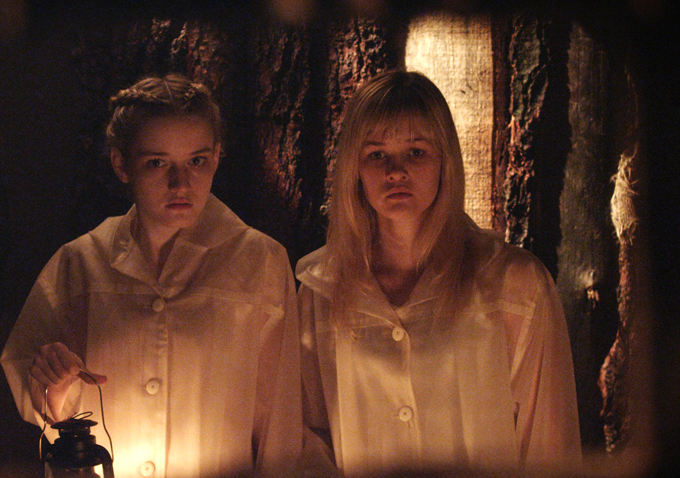
“When I saw his movie,” said director Jim Mickle at Cannes earlier this year, in his opening thank you to Jorge Michel Grau, the director of “Somos Lo Que Hay,” “I was jealous of everything: the idea, the plot, the style, and jealous that it was playing at Cannes in Director’s Week.” And so Mickle went about securing the rights to remake the hit Mexican film, co-opting the idea, the plot and elements of the style for his English-language “We Are What We Are,” co-written with frequent collaborator Nick Damici, which also landed in the Cannes Directors’ Fortnight earlier this year. It’s a nice narrative to have surround your picture, and the admiration between the directors is mutual, with Grau giving Mickle’s take fulsome, glowing praise, even calling it “an improvement of my story.” We admired the original, so could that dirtiest of concepts, the U.S. remake, possibly live up to all the excited chatter? Happily, it does, pulling off the rare trick of remaking a strong original into a strong new version that honors the story but provides a different slant on it that feels as authentic to its transposed environment as the original did to its setting. It does a “Let Me In,” shall we say, rather than a Platinum Dunes.

Building slowly, and in a controlled, low-key and unshowy fashion—especially for a cannibal horror film—Mickle’s “We Are What We Are” begins with the death of the clearly gravely ill Parker family matriarch Emma (Kassie DePaiva) during a bout of heavy flooding. After this initial drama, the film then takes its time establishing mood, character and the interpersonal relationships amongst her surviving family—daughters Iris (Ambyr Childers) and Rose (Julia Garner), little boy Rory (Jack Gore) and paterfamilias Frank (Bill Sage)—along with their small circle of acquaintances, comprising of the local deputy Anders (Wyatt Russell) who has a crush on Iris, town doctor Doc Barrow (Michael Parks) and kindly neighbor Marge (Kelly McGillis, is that really you?). The now-motherless Parkers are devout to a mysterious religion of seemingly their own devising, which revolves around an old diary and something they call Lamb Day, due to happen in just a few days’ time. And without her mother around, eldest daughter Iris is expected to take on her duties, however deviant they may be. Meanwhile Doc, himself pining for his disappeared daughter, discovers a human bone in the nearby creek and embarks on a a little medical sleuthing, recruiting Anders to his cause along the way, while a local girl goes missing and the family, involved in a draconian fasting ritual prior to Lamb Day, are getting hungry.
The lines are clearly, delicately drawn in a melancholic minor key of damp and chilly unease, with Mickle employing beautiful, grey-washed, rain-soaked photography, and getting strong, underplayed performances even from the youngest members of his cast. The sense of mood is so well established that when the violence comes, it disgusts as it should, but it doesn’t necessarily jar: these moments manage to be both grisly (occasionally gristly), and still in keeping with the film’s haunted, ghost-story feel, which is no mean feat. This slow-build rhythm, though, really pays off in the final moments, with an extended gruesome resolution scene that is as thematically and narratively satisfying as it is deliriously grotesque. And there’s no way we could have gotten there so wholeheartedly if the set up had been one iota less considered. In fact, it had the audience at our screening clapping, laughing and hiding their faces in a confusion of reactions to the cathartic horribleness going on onscreen.

The social context of the original film (the cheapness of life among the Mexican underclasses) formed an important aspect of its impact—here that particular angle is obviously abandoned in favor of a greater emphasis on the religious, ritualistic aspect of the family’s dark secret. Inasmuch as the best horrors can usually be read as allegories for something or other, “We Are What We Are” hasn’t quite enough meat on its bones (sorry) to support its analysis as a critique of religious isolationism, but that aspect does lend the story depths and resonances it might not otherwise have. The children’s sense of their own otherness, and the different moral standards that their “lifestyle” demands they embrace, is that bit more believable when cast in the context of a cultish, controlled upbringing. And there’s interest to be had knitting some of the plot mechanics—the sin-revealing flood, for example—to their mythic, religious counterparts.
But really, “We Are What We Are” is just a great yarn, well-acted, elegantly shot and put together cleverly so that even its more visceral delights feel well-earned. It will likely disappoint the “buckets of blood” brigade, but for anyone looking for a horror movie with smarts, that stops just shy of being anything as po-faced as “thought-provoking” in favor of just being a great time at the movies, “We Are What We Are” entirely delivers. Enjoy with some fava beans and nice Chianti. [B+]
The is a reprint of our review from the Cannes Film Festival.

